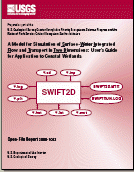
OFR 2005-1033
Prepared as part of the
U.S. Geological Survey Greater Everglades Priority Ecosystems Science Program and the
National Park Service Critical Ecosystem Studies Initiative
2005

|
Select an option: |
|
Abstract Introduction Past Applications Acknowledgments SWIFT2D Modifications Formulation and Terminology Modifications for Coastal Wetland Simulation Time-Varying Areal Rainfall Spatially Detailed Evapotranspiration Wind Sheltering Variations in Frictional Resistance with Depth Computational Cells Adjacent to Flow Barriers Other Code Modifications Summary References Cited Appendix I SWIFT2D Equations Finite-Difference Forms Alternating Direct Implicit Solution Appendix II.SWIFT2D Program Input with Modifications for Application to Coastal Wetlands Part 1: Records - Control Parameters Part 2: Records - Initial Array Data Part 3: Records - Time-Varying Data
|
The computation of hydrodynamic flow in two dimensions is implemented in the Surface-Water Integrated Flow and Transport in Two-Dimensions (SWIFT2D) model using a numerical code that also includes computation of reactive constituent transport, density variation effects, drying and wetting of periodically inundated areas, and hydraulic structures. The model can be utilized in a variety of settings where velocity and concentration gradients can be assumed to have minimal vertical variations, and the representation of flow in two horizontal dimensions is sufficient. The finite-difference forms of the equations of mass continuity and momentum are solved in two dimensions by the use of a staggered timestep solution solved with an efficient alternating-direction implicit solution. The finite-difference forms of the constituent transport equations can be solved in conjunction with the flow equations. If salt transport is simulated, an equation of state relates the density terms in the momentum equation to salinity.
The traditional formulation of SWIFT2D has been applied to numerous estuaries, bays, and harbors throughout the world. Modifications have been made to expand SWIFT2D for applicability to shallow coastal wetlands. These modifications include the representation of spatially and temporally varying rainfall and evapotranspiration, wind sheltering owing to effects of emergent vegetation, and changes in frictional resistance with depth. These modifications expand the versatility of the codeís applications to include open freshwater or saltwater conditions along coasts and within embayments and estuaries as well as associated fresh, brackish, and hypersaline wetlands and marshes linked to such water bodies. Inclusion of precipitation and evapotranspiration processes also permits long-term simulations.
Swain, E.D., 2005, A Model for Simulation of Surface-Water Integrated Flow and Transport in Two Dimensions: Userís Guide for Application to Coastal Wetlands: U.S. Geological Survey Open-File Report 2005-1033, 88 p.
U.S. Department of the Interior,
U.S. Geological Survey
Suite 106 & 107
9100 NW 36th St.
Miami, FL 33178
edswain@usgs.gov@usgs.gov
| AccessibilityFOIAPrivacyPolicies and Notices | |
 |
|